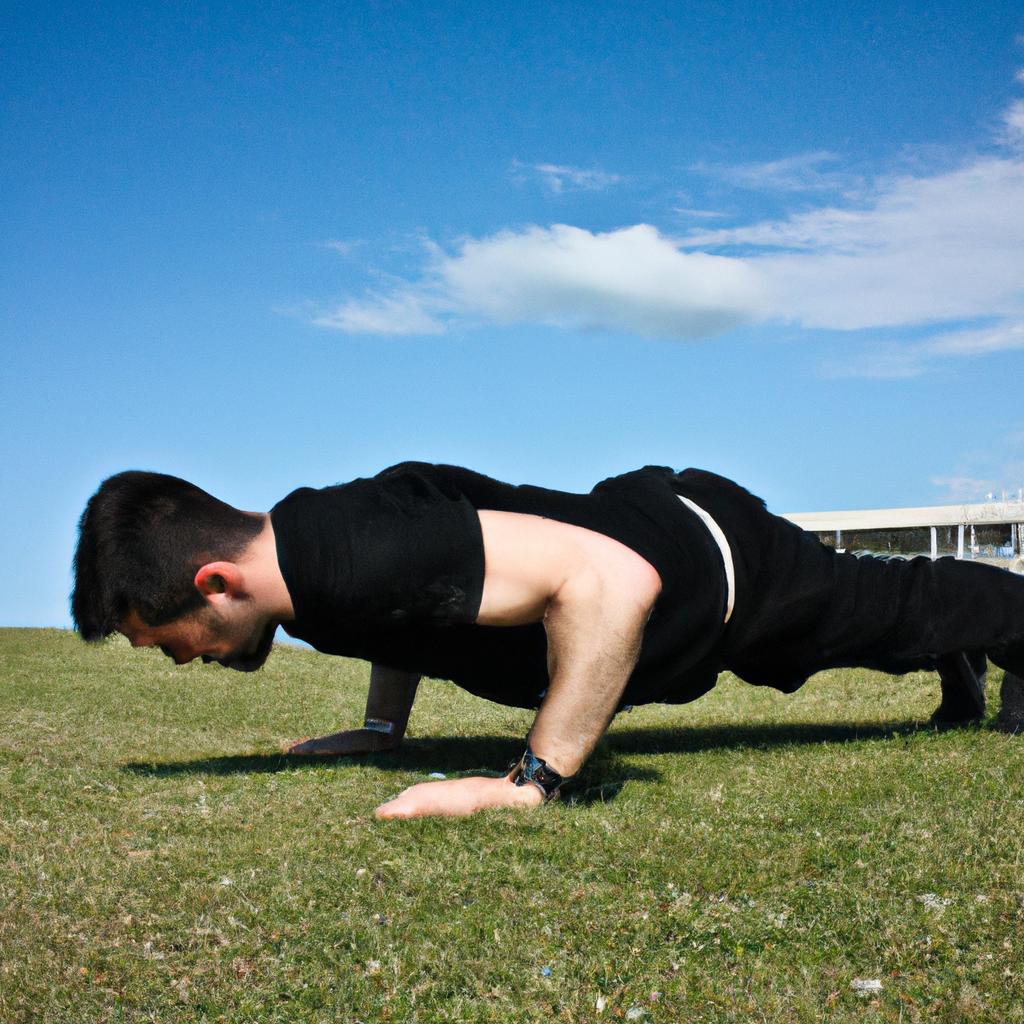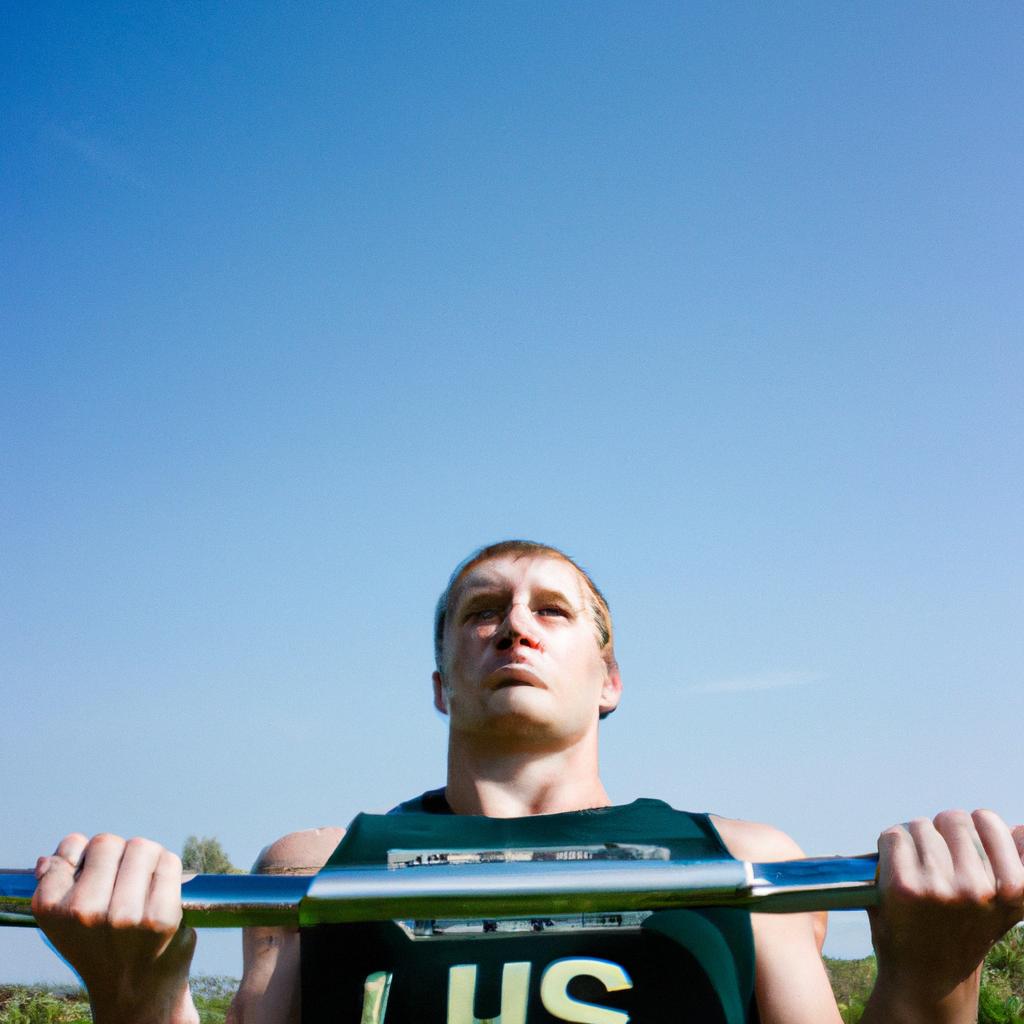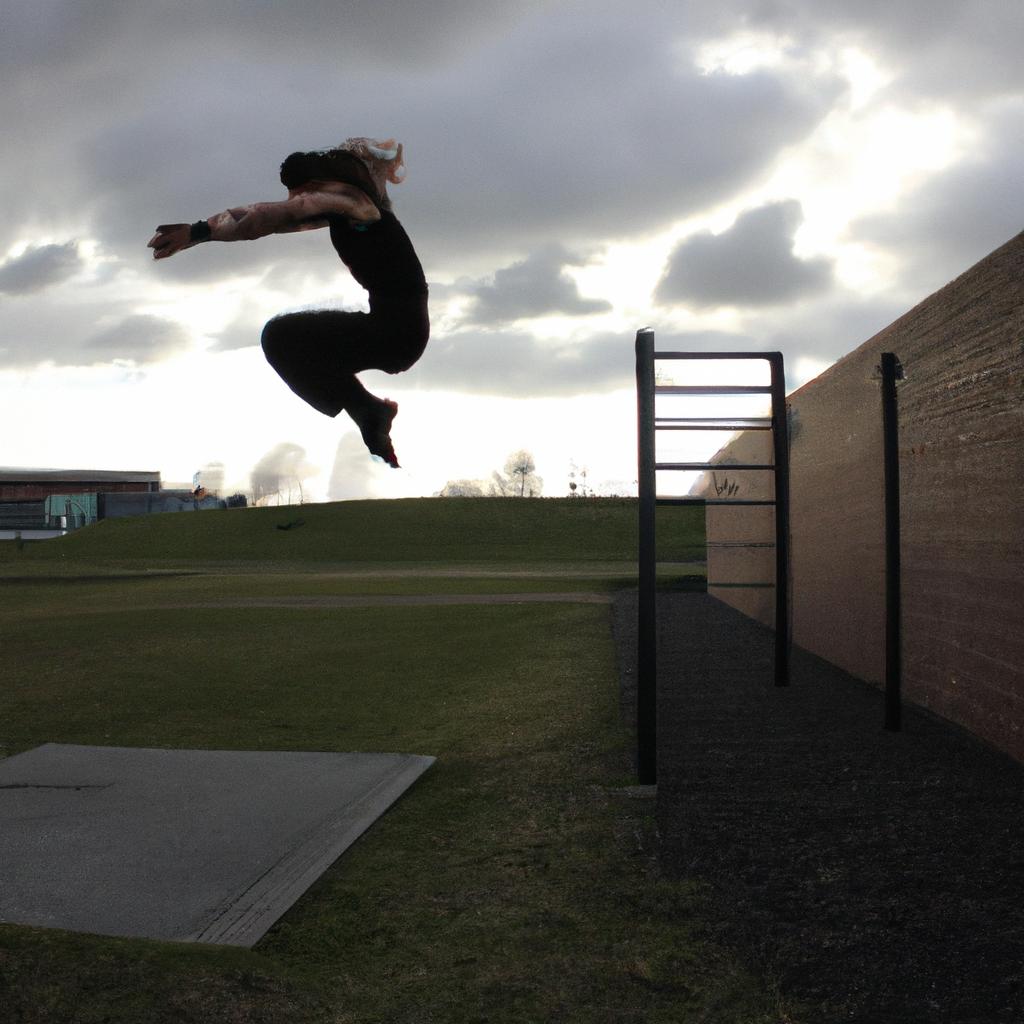The demand for bodyweight exercises in fitness studios has significantly increased over the past decade. These exercises, which utilize an individual’s own body weight as resistance, have proven to be highly effective in improving strength and overall fitness levels. For instance, imagine a hypothetical case study of Jane, a middle-aged woman who had been struggling with traditional weightlifting routines due to joint pain. After incorporating bodyweight exercises into her training regimen, she experienced significant improvements in both muscle tone and functional strength without exacerbating her joint issues.
In recent years, fitness enthusiasts have become increasingly interested in alternative approaches to strength training that do not rely solely on heavy weights and machines. Bodyweight exercises provide an appealing solution by offering a versatile form of resistance that can be performed anywhere without the need for expensive equipment or specialized facilities. This trend is particularly evident within fitness studios, where trainers are now incorporating various types of bodyweight exercises into their programs to cater to clients seeking alternatives to traditional weightlifting methods. The benefits of these exercises extend beyond mere convenience; they also promote greater mobility, coordination, and stability while simultaneously building muscular strength and endurance. As a result, more individuals are turning to bodyweight workouts as an effective means of achieving their fitness goals – whether it be toning muscles, improving cardiovascular fitness, or increasing flexibility.
One of the major advantages of bodyweight exercises is that they can be modified to suit individuals of all fitness levels. Whether someone is a beginner or an advanced athlete, there are countless variations and progressions available for each exercise. This versatility allows trainers to tailor workouts specifically to their clients’ needs and goals, ensuring that they are challenged appropriately without risking injury or overexertion.
Additionally, bodyweight exercises often engage multiple muscle groups simultaneously, leading to improved overall functional strength. Movements such as push-ups, squats, lunges, and planks require coordination and stability from various parts of the body, resulting in better balance and control. These exercises also activate core muscles throughout the movements, contributing to improved posture and reduced risk of back pain.
Another benefit of bodyweight exercises is their potential for high-intensity interval training (HIIT). By combining bursts of intense effort with short rest periods, HIIT workouts can effectively improve cardiovascular fitness while simultaneously building muscular endurance. This form of training has gained popularity due to its efficiency in burning calories and improving metabolic health.
In summary, the increased demand for bodyweight exercises in fitness studios reflects a growing appreciation for their effectiveness in improving strength and overall fitness levels. With their versatility, accessibility, and ability to cater to individuals of all fitness levels, these exercises provide a valuable alternative to traditional weightlifting methods. As more people recognize the benefits of bodyweight workouts – including improved muscle tone, functional strength, mobility, coordination, and stability – it is likely that this trend will continue to grow in popularity within the fitness industry.
Benefits of Bodyweight Exercises
Benefits of Bodyweight Exercises
Imagine a fitness enthusiast who is looking for an effective and versatile training method that can be done virtually anywhere, without the need for specialized equipment. This is where bodyweight exercises come into play as a valuable option. By utilizing only one’s own body weight as resistance, these exercises offer numerous benefits for individuals seeking to enhance their strength and overall fitness levels.
Firstly, bodyweight exercises are highly accessible, making them suitable for people of all ages and fitness levels. Regardless of whether someone is just starting their fitness journey or is already experienced in strength training, these exercises can be tailored to suit individual needs and capabilities. The versatility allows beginners to gradually increase intensity over time while challenging advanced athletes with more complex variations.
Secondly, engaging in bodyweight exercises provides an efficient way to build functional strength. Unlike traditional gym equipment that often isolates specific muscles, bodyweight exercises require multiple muscle groups to work together simultaneously. This results in improved coordination, stability, and balance – essential components for everyday activities and sports performance alike.
Furthermore, incorporating bodyweight exercises into a workout routine offers convenience and flexibility. With no reliance on weights or machines, individuals have the freedom to exercise whenever and wherever they choose. Whether it’s at home, outdoors, or during travel, bodyweight workouts eliminate barriers such as limited access to equipment or overcrowded gyms.
To further emphasize the advantages of bodyweight exercises:
- They promote increased calorie burn due to their high-intensity nature.
- They help develop lean muscle mass while improving muscular endurance.
- They boost cardiovascular health by raising heart rate during dynamic movements.
- They provide mental benefits like stress reduction and improved mood through physical activity.
| Benefit | Description |
|---|---|
| Convenience | Can be performed anywhere |
| Versatility | Suitable for various abilities |
| Efficiency | Targets multiple muscle groups |
| Accessibility | No need for specialized equipment |
In summary, bodyweight exercises offer a range of benefits that make them an appealing choice for individuals seeking to improve their strength and overall fitness levels. The accessibility, functional nature, and convenience they provide contribute to their popularity as a versatile training method.
Transitioning into the subsequent section about “Essential Equipment for Bodyweight Workouts,” it becomes evident that although no external weights are required for bodyweight exercises, certain accessories can enhance the effectiveness and variety of workouts.
Essential Equipment for Bodyweight Workouts
Imagine a fitness studio where individuals from all walks of life come together to improve their strength and overall fitness. Among the various training methods available, bodyweight exercises have gained popularity for their simplicity and effectiveness. Let’s explore how incorporating bodyweight exercises into your fitness routine can help you build strength and achieve your fitness goals.
One compelling example is Sarah, a 35-year-old office worker who recently joined the fitness studio. She had always struggled with finding time for exercise amidst her busy schedule. However, after discovering the benefits of bodyweight exercises, she decided to give them a try. Within weeks of consistent training, Sarah noticed significant improvements in her strength and endurance levels. Not only did she feel stronger during daily activities like carrying groceries or climbing stairs, but she also experienced higher energy levels throughout the day.
Incorporating bodyweight exercises into your fitness routine offers several key advantages:
- Convenience: With no need for specialized equipment, bodyweight exercises can be performed anywhere at any time.
- Full-body engagement: These exercises engage multiple muscle groups simultaneously, leading to better overall functional strength.
- Versatility: There is a wide variety of bodyweight exercises that target different muscles and movement patterns, allowing you to customize your workouts based on specific goals.
- Injury prevention: As these exercises rely on natural movements using one’s own body weight as resistance, they place less stress on joints compared to heavy weights.
To further illustrate the versatility of bodyweight exercises, consider the following table showcasing some common movements:
| Exercise | Targeted Muscle Groups | Benefits |
|---|---|---|
| Push-ups | Chest, triceps, core | Builds upper body strength |
| Squats | Quadriceps, glutes | Enhances lower body power |
| Plank | Abdominals | Improves core stability |
| Lunges | Hamstrings, calves | Develops leg strength and balance |
By incorporating these exercises into your fitness routine, you can experience the benefits of bodyweight training firsthand. In addition to building overall strength, focusing on specific muscle groups will help you achieve a well-rounded physique.
As we delve further into this guide, we will explore effective upper body exercises that can be performed using just your body weight. By targeting different muscle groups individually, you can enhance both your functional strength and aesthetic appeal. So let’s move forward and discover how to develop a stronger upper body through bodyweight exercises.
Effective Upper Body Exercises
Section H2: Effective Upper Body Exercises
As we have discussed the essential equipment for bodyweight workouts, let us now explore effective upper body exercises that can be incorporated into your fitness studio strength training routine. These exercises focus on developing strength and toning in the muscles of the upper body, including the arms, shoulders, chest, and back.
One example of an effective upper body exercise is the push-up. This classic exercise targets multiple muscle groups simultaneously, making it a great addition to any workout regimen. To perform a push-up correctly, start by assuming a plank position with your hands slightly wider than shoulder-width apart. Lower your body towards the ground by bending your elbows until your chest is just above the floor. Push yourself back up to the starting position while keeping your core engaged throughout the movement.
To help you understand why incorporating upper body exercises into your fitness routine is important, here are some benefits:
- Improved muscular strength: Regularly performing upper body exercises helps increase overall muscular strength in areas such as the arms, shoulders, and chest.
- Enhanced functional movements: Strengthening these muscle groups allows for better performance in daily activities that involve pushing or lifting objects.
- Posture improvement: Stronger upper body muscles contribute to improved posture by supporting proper alignment of the spine and reducing slouching.
- Increased calorie burn: Engaging larger muscle groups through upper body exercises can help boost metabolism and aid weight loss efforts.
Consider utilizing different variations of push-ups, such as diamond push-ups or decline push-ups, to further challenge and target specific areas within your upper body.
| Exercise | Targeted Muscle Groups | Sets/Reps Range |
|---|---|---|
| Push-Up | Chest, Shoulders, Triceps | 3 sets of 10-15 reps |
| Pull-Up | Back, Biceps | 3 sets of 8-12 reps |
| Dumbbell Shoulder Press | Shoulders | 3 sets of 8-12 reps |
| Plank | Core, Upper Body | Hold for 30-60 seconds |
Incorporating these upper body exercises into your fitness studio strength training routine can provide a well-rounded workout and help you achieve your fitness goals.
Now let’s shift our focus to challenging lower body exercises that will further enhance your overall strength and endurance.
Challenging Lower Body Exercises
Transition from the previous section H2:
Having discussed effective upper body exercises, let us now turn our attention to challenging lower body exercises that can be incorporated into your fitness studio strength training routine. These exercises will not only help you build muscle and improve overall strength but also enhance your mobility and flexibility.
Challenging Lower Body Exercises
To illustrate the effectiveness of these lower body exercises, consider the following example: Sarah, a regular visitor to her local fitness studio, had been struggling with knee pain due to weak quadriceps muscles. Her trainer introduced her to a series of lower body exercises that targeted those specific muscles. With consistent practice over several weeks, Sarah noticed significant improvement in both her knee stability and overall leg strength.
Incorporating challenging lower body exercises into your fitness routine can offer numerous benefits. Here are four key advantages:
- Improved balance and stability
- Increased muscular endurance
- Enhanced athletic performance
- Reduced risk of injuries
Let’s take a closer look at some popular lower body exercises that can be easily performed using just your own bodyweight:
| Exercise | Targeted Muscles | Benefits |
|---|---|---|
| Squats | Quadriceps, Glutes | Builds leg strength |
| Lunges | Quads, Hamstrings | Enhances balance and coordination |
| Step-ups | Glutes, Calves | Improves explosive power |
| Bulgarian Split Squats | Quads, Glutes | Increases unilateral leg strength |
By incorporating these challenging lower body exercises into your fitness studio strength training sessions, you can experience improved physical performance while minimizing the risk of injury. Next, we will further explore core strengthening bodyweight moves that will complement and complete your well-rounded exercise routine.
Transition sentence for subsequent section on “Core Strengthening Bodyweight Moves”:
Now let’s shift our focus towards core strengthening bodyweight moves that will further enhance your overall strength and stability.
Core Strengthening Bodyweight Moves
Challenging Lower Body Exercises: Building Strength and Endurance
Imagine you’re a fitness enthusiast looking to take your strength training routine to the next level. Incorporating challenging lower body exercises into your workout can help you achieve just that. Let’s explore some effective moves that will target different muscle groups in your lower body, providing both strength and endurance benefits.
One example of a demanding lower body exercise is the Bulgarian split squat. This move specifically targets the quads, glutes, and hamstrings while also improving balance and stability. To perform this exercise, start by standing with one foot forward and the other placed behind you on an elevated surface such as a bench or step. Slowly lower yourself down until your back knee almost touches the ground, then push through your front heel to return to the starting position.
Incorporating these challenging lower body exercises into your fitness studio strength training routine can provide numerous benefits for overall fitness. Here are some key advantages:
- Increased muscular strength: Performing compound movements like squats and lunges engages multiple muscles simultaneously, leading to improved overall lower body strength.
- Enhanced athletic performance: Strong legs contribute to better performance in various sports activities such as running, jumping, and agility-based movements.
- Improved bone density: Weight-bearing exercises stimulate bone growth, reducing the risk of osteoporosis later in life.
- Boosted metabolism: Intense lower body workouts can increase calorie burn during exercise and even after finishing your workout session.
To help visualize how these exercises may fit into your routine, consider the following table outlining sample sets and repetitions:
| Exercise | Sets | Repetitions |
|---|---|---|
| Squats | 3 | 12-15 |
| Lunges | 4 | 10 each leg |
| Deadlifts | 3 | 8-10 |
| Calf Raises | 3 | 15-20 |
By incorporating these challenging lower body exercises and following a well-designed routine, you can improve your strength and endurance levels.
Transitioning into Advanced Variations for Progression, let’s delve deeper into more demanding ways to challenge your lower body muscles.
Advanced Variations for Progression
In the previous section, we explored various bodyweight exercises that target and strengthen the core muscles. Now, let’s delve into advanced variations of these moves to further challenge your fitness levels and create progression in your strength training routine.
Imagine you have been consistently practicing standard plank exercises for several weeks and are ready to take it up a notch. Introducing the “plank with leg lift” variation can help enhance both your core stability and overall balance. By lifting one leg off the ground while maintaining a straight body position, you engage additional muscles to stabilize yourself, intensifying the exercise.
To continue progressing in your bodyweight training journey, consider incorporating the following techniques:
- Increase time under tension: Slow down each rep by taking more time during both the concentric (lifting) and eccentric (lowering) phases of an exercise. This prolongs muscle engagement and promotes better muscle fiber recruitment.
- Implement unilateral movements: Focus on single-limb exercises like lunges or single-leg squats to improve balance, coordination, and stability while targeting specific muscle groups individually.
- Utilize resistance bands: Incorporate resistance bands into bodyweight exercises to add external resistance without relying on weights or machines. This helps increase muscular endurance and provides variability in resistance throughout different ranges of motion.
- Try plyometric exercises: Include explosive movements such as jump squats or burpees to develop power, agility, and cardiovascular endurance alongside strength gains from traditional bodyweight exercises.
Now let’s explore these concepts further through a table that highlights some key features of each technique:
| Technique | Benefits |
|---|---|
| Increased Time Under Tension | – Enhances muscle hypertrophy- Builds greater muscular endurance- Improves mind-muscle connection |
| Unilateral Movements | – Balances bilateral asymmetries- Strengthens stabilizer muscles- Develops proprioception |
| Resistance Bands | – Adds progressive resistance- Provides accommodating resistance- Increases exercise versatility |
| Plyometric Exercises | – Boosts power and explosiveness- Improves cardiovascular fitness- Enhances fast-twitch muscle fiber activation |
Incorporating these advanced variations and techniques into your bodyweight training routine can take your strength, stability, and overall fitness to new heights. Remember to progress gradually and listen to your body’s feedback to avoid injury or overexertion. By exploring the possibilities of bodyweight exercises, you can continually challenge yourself on your fitness journey.




